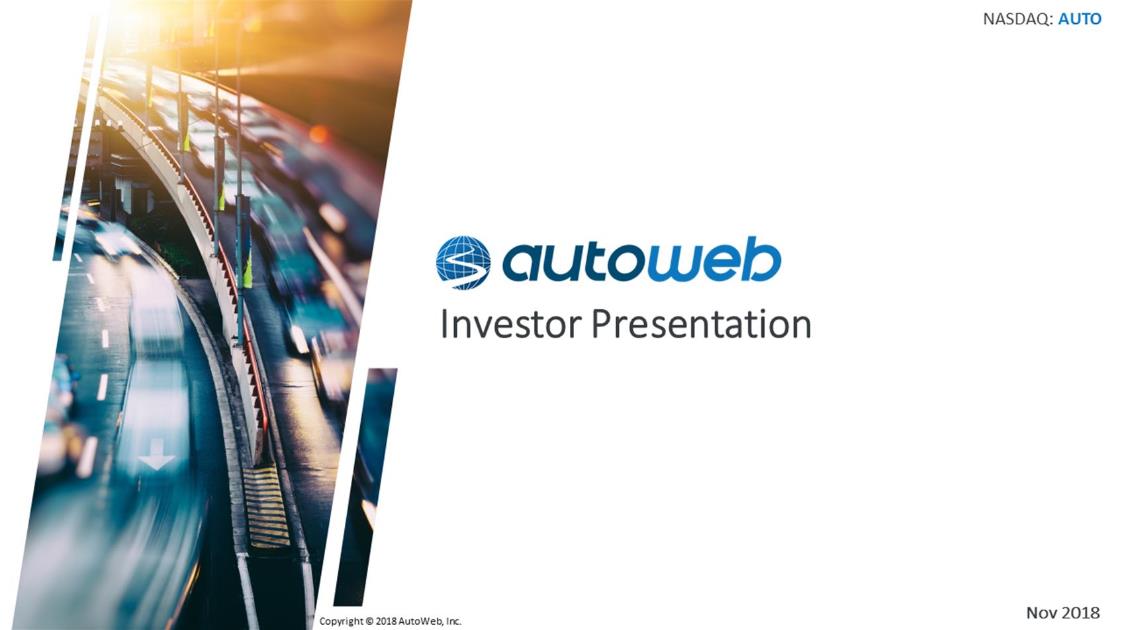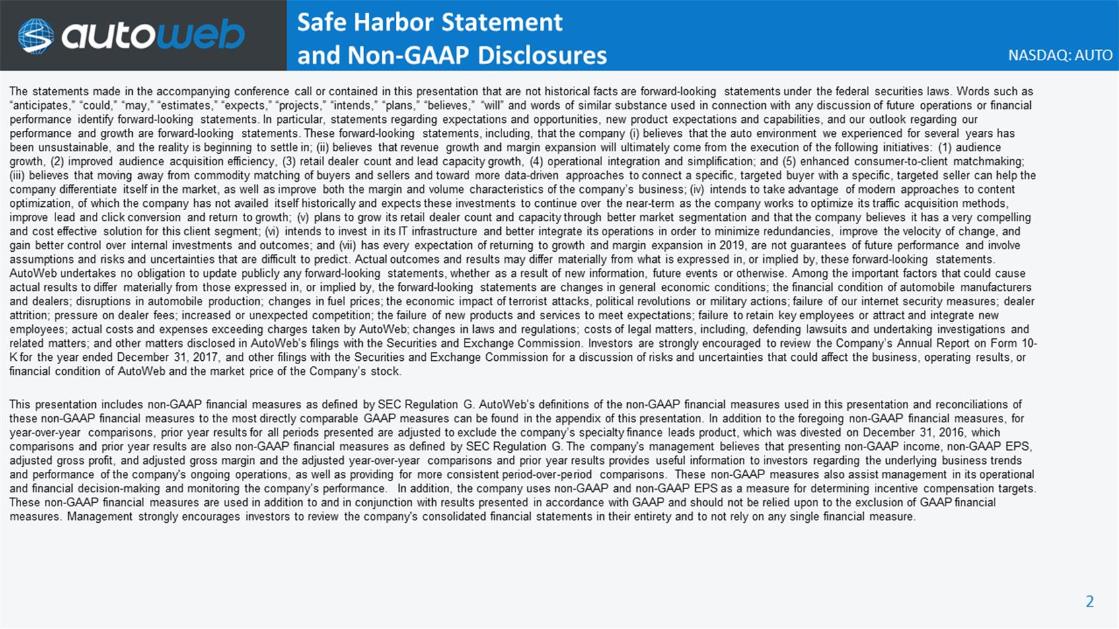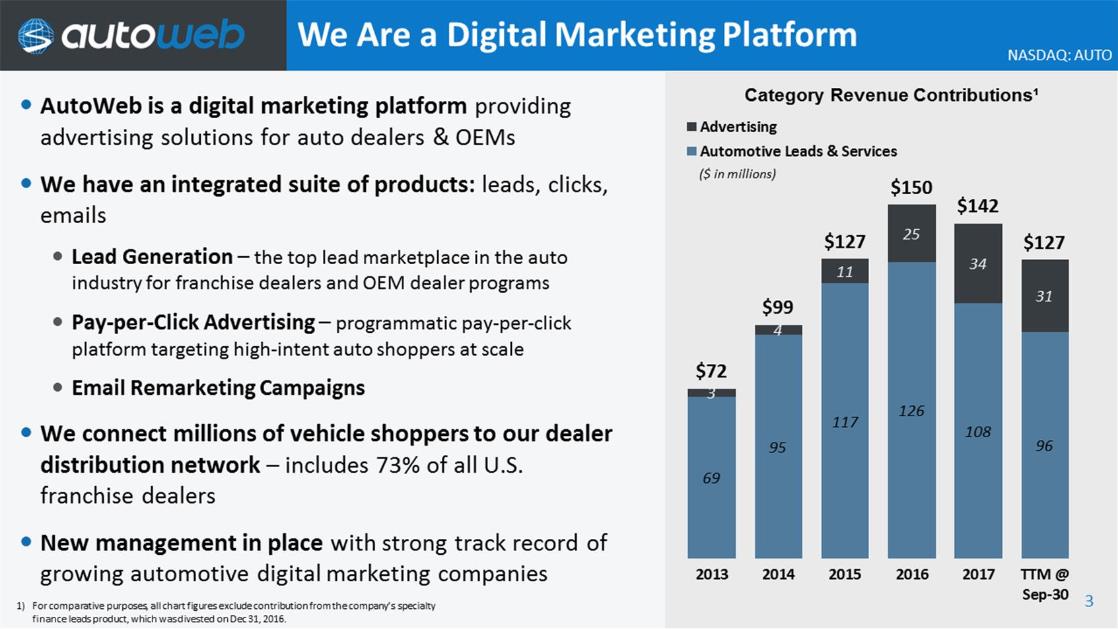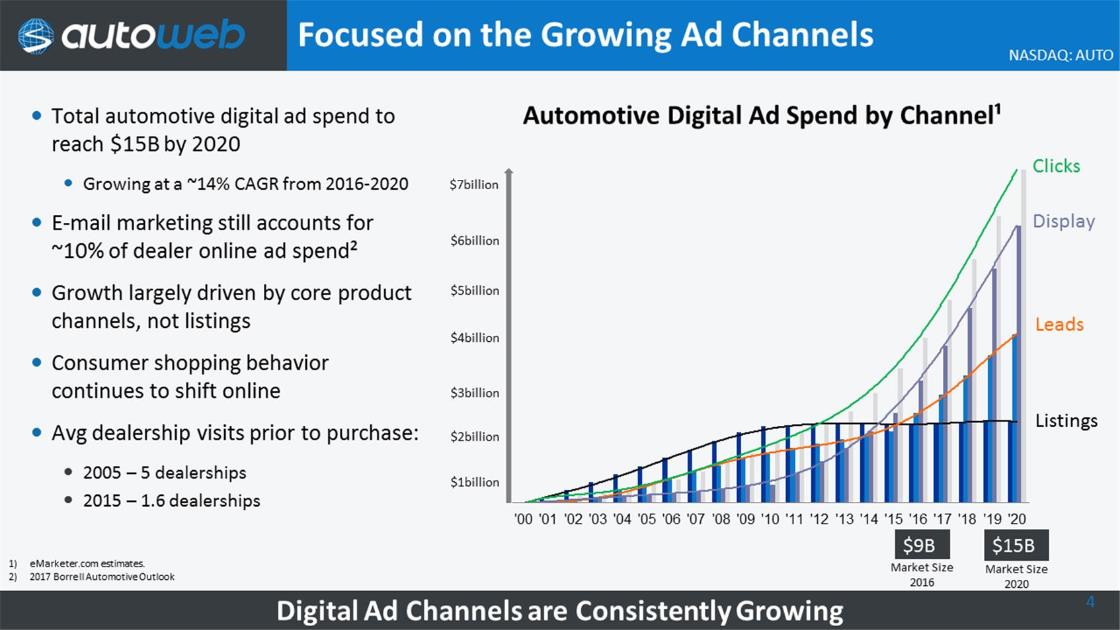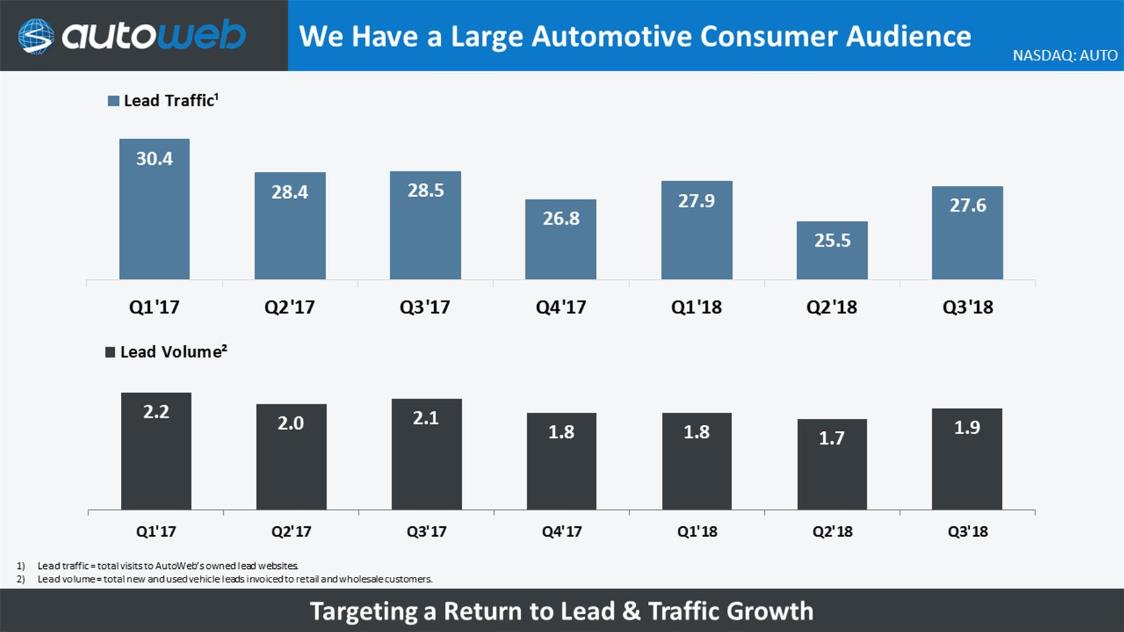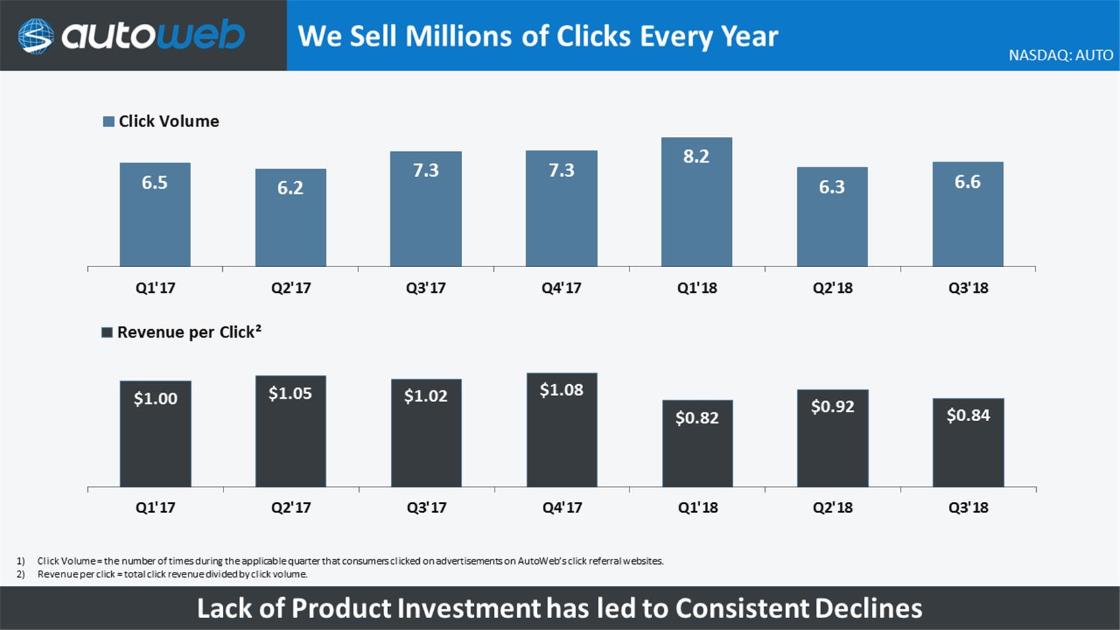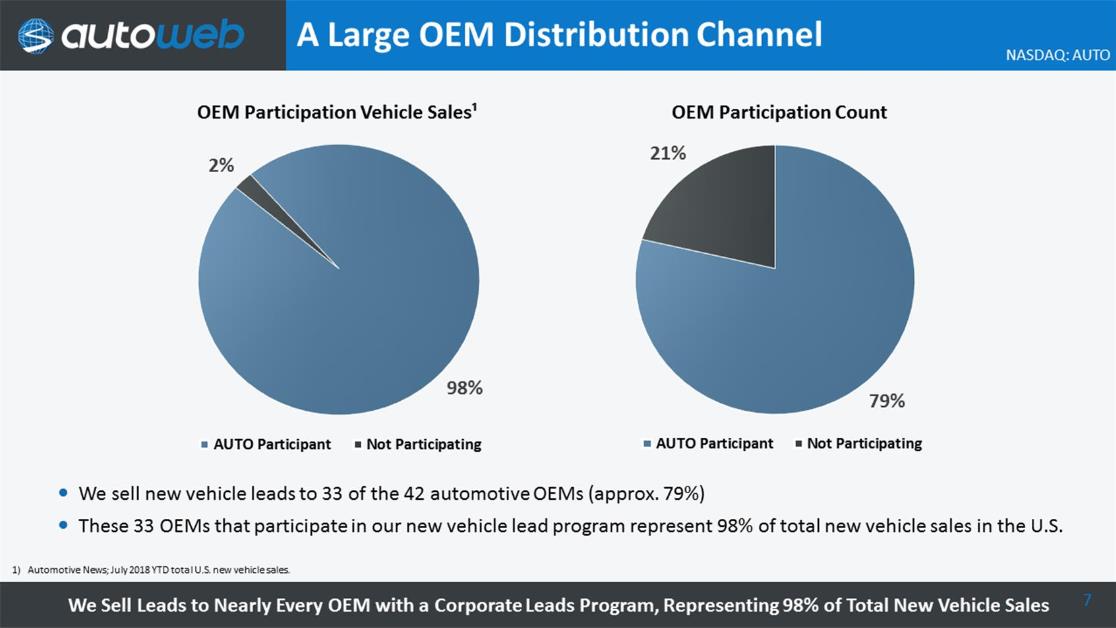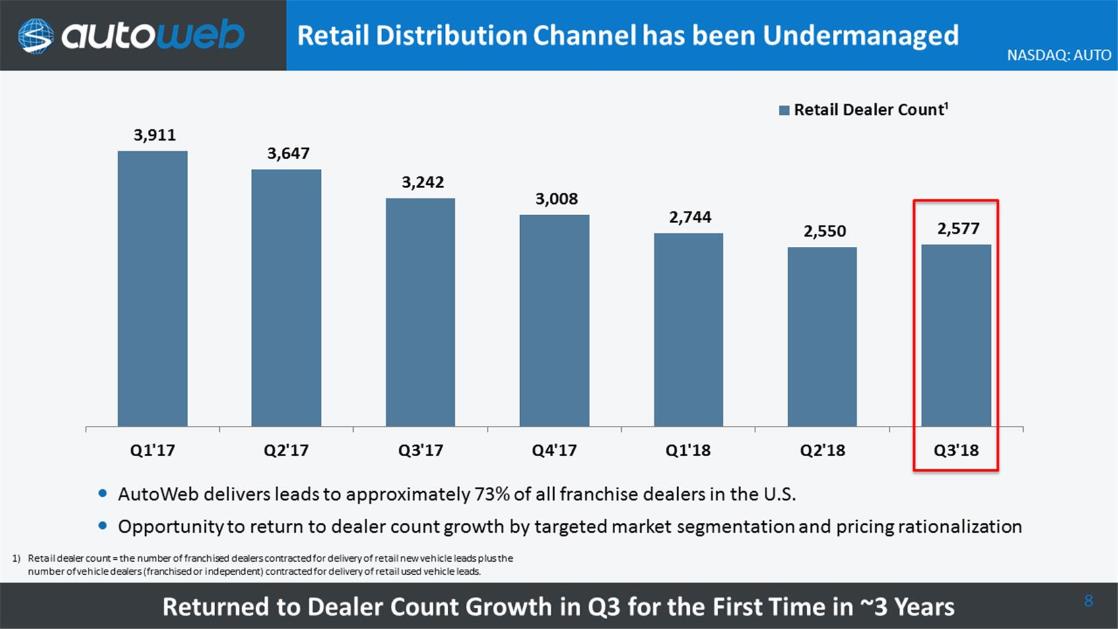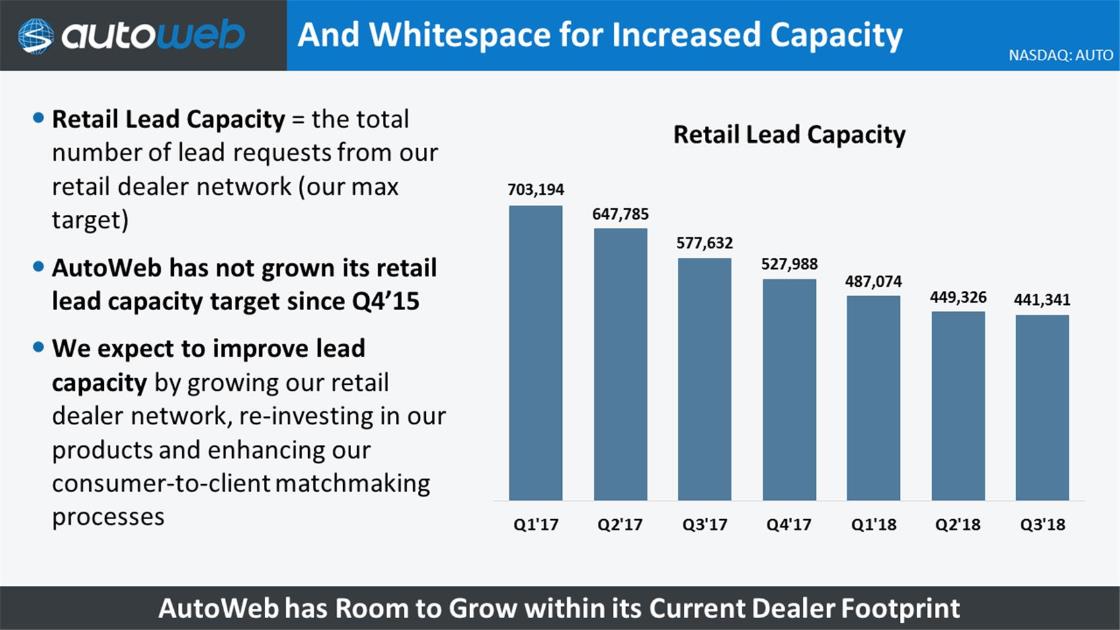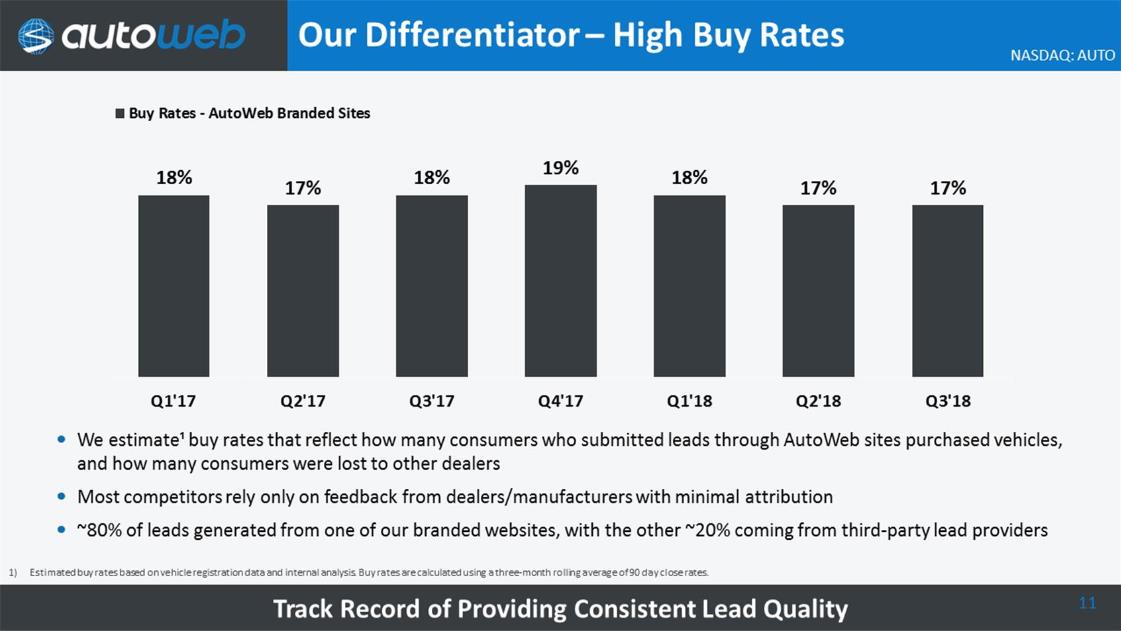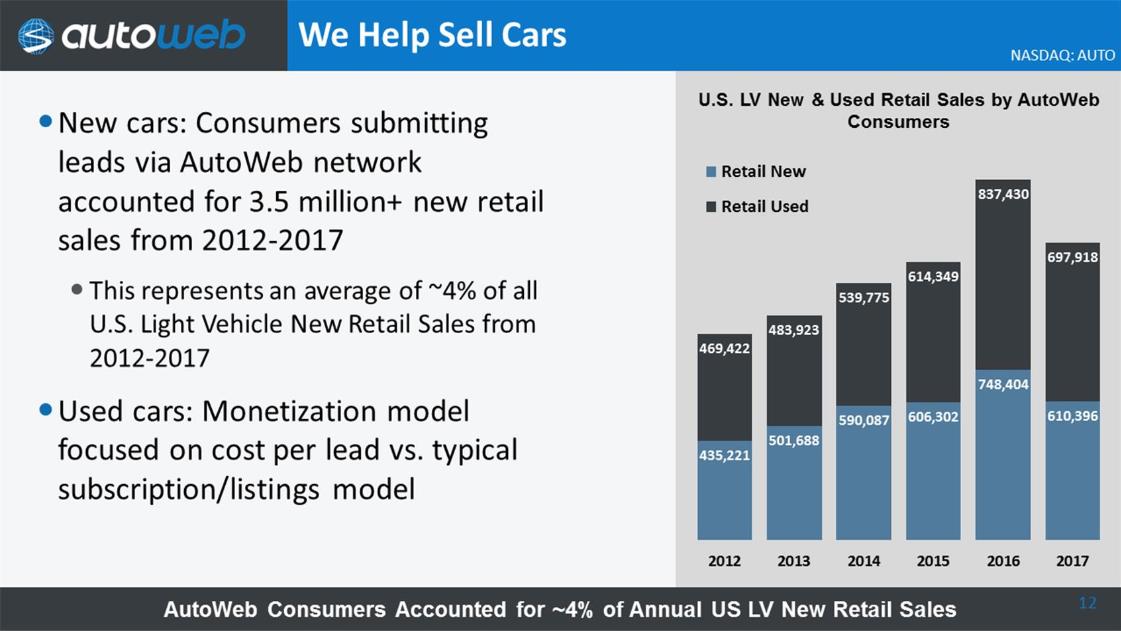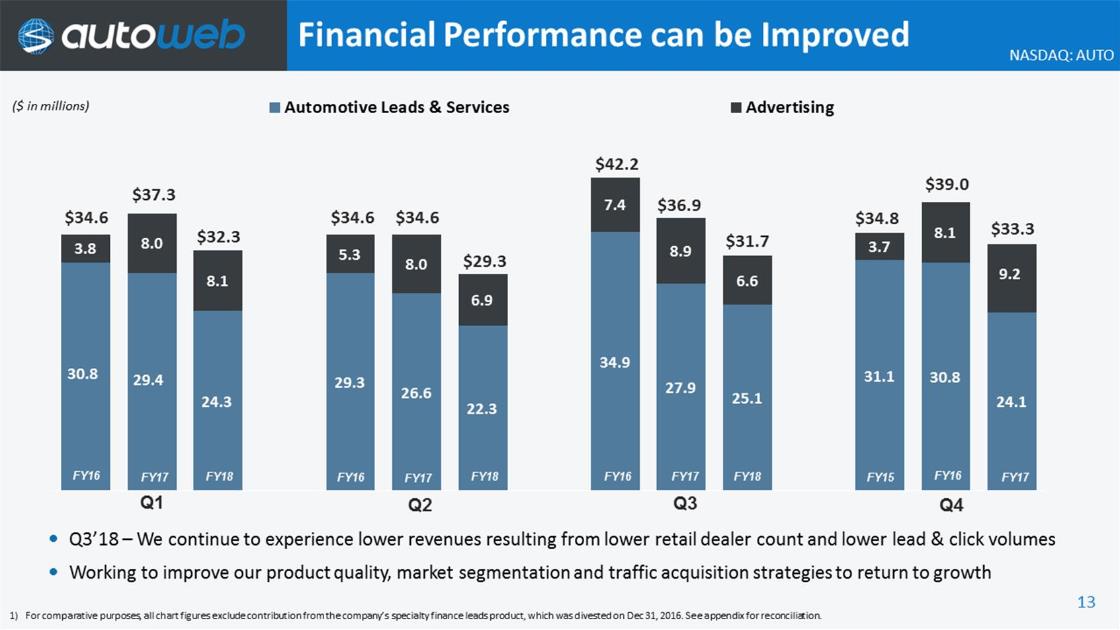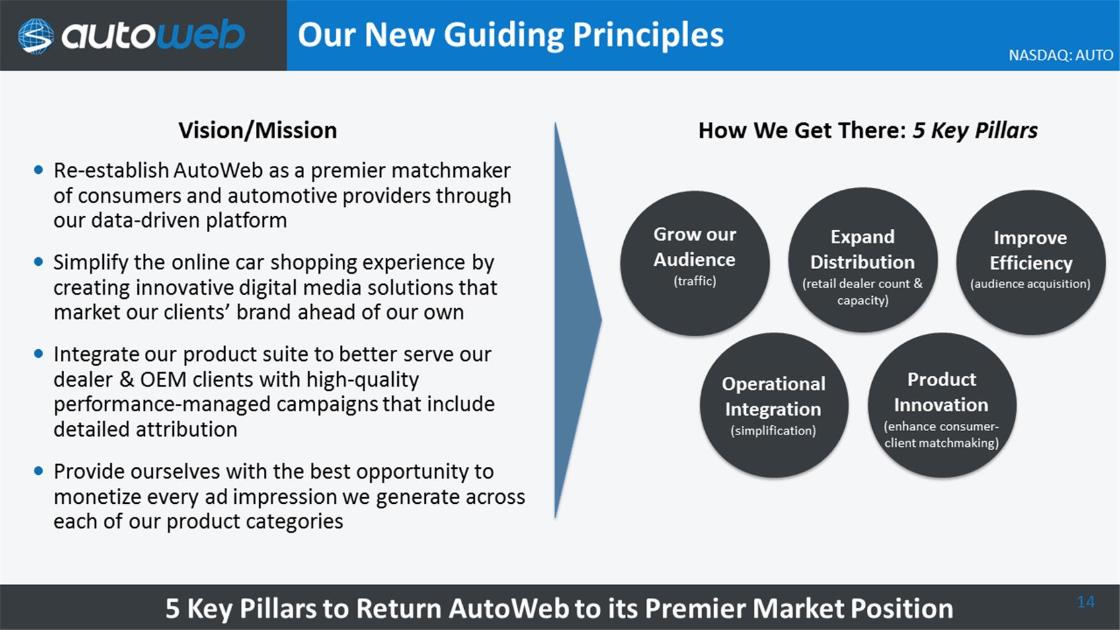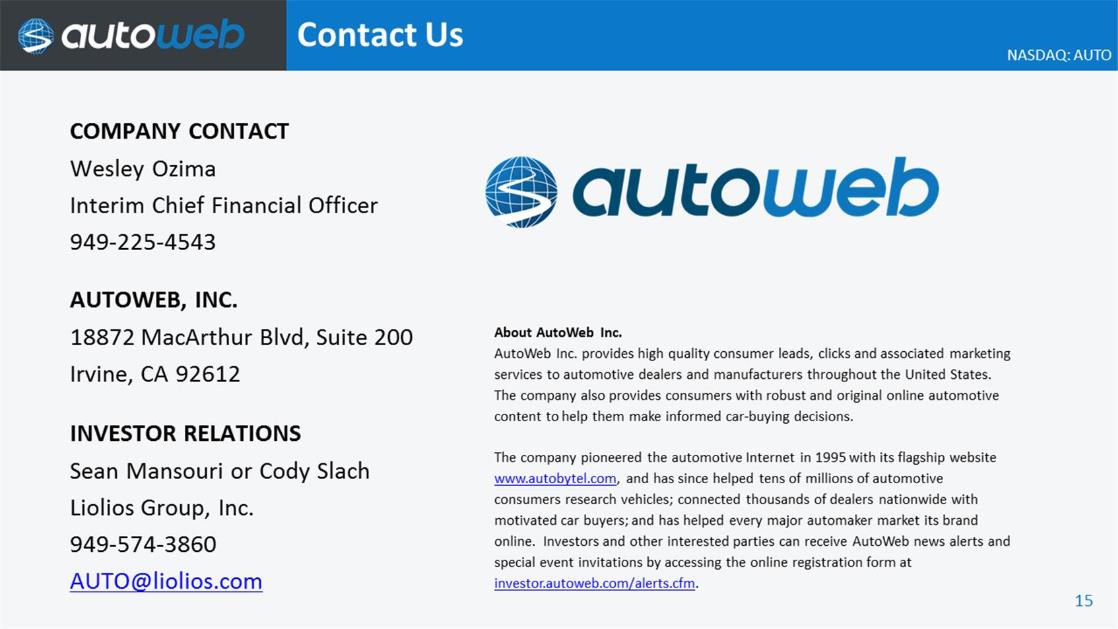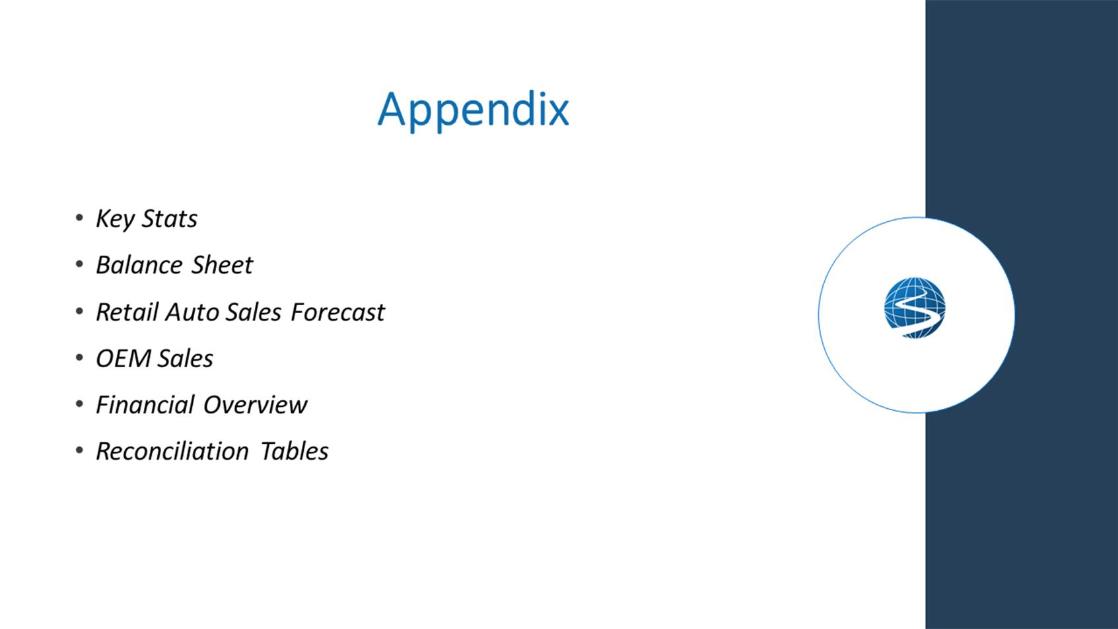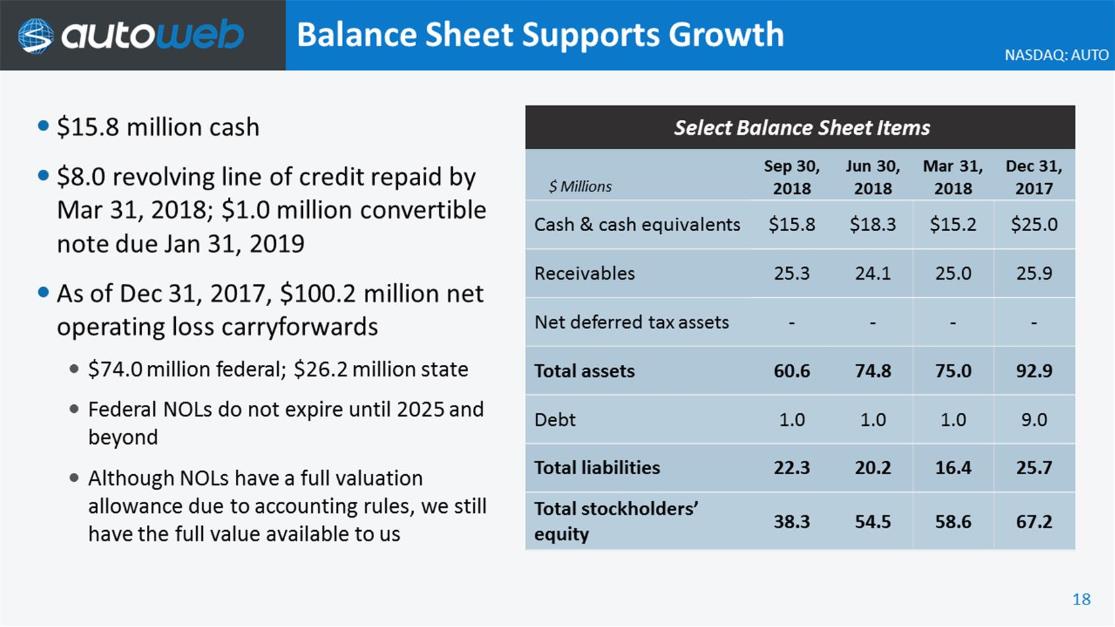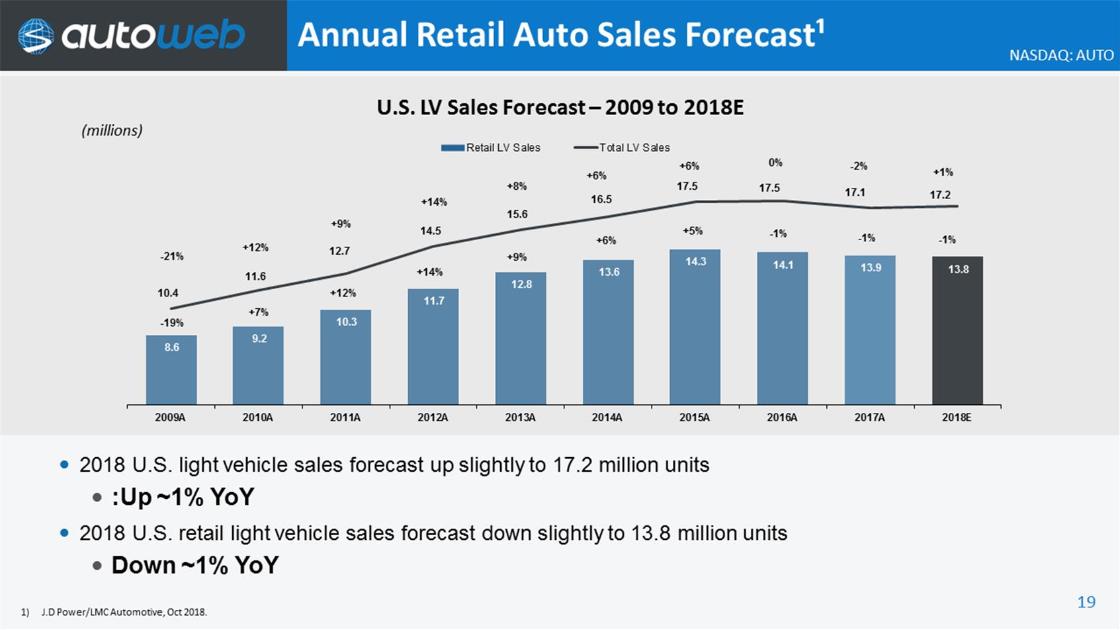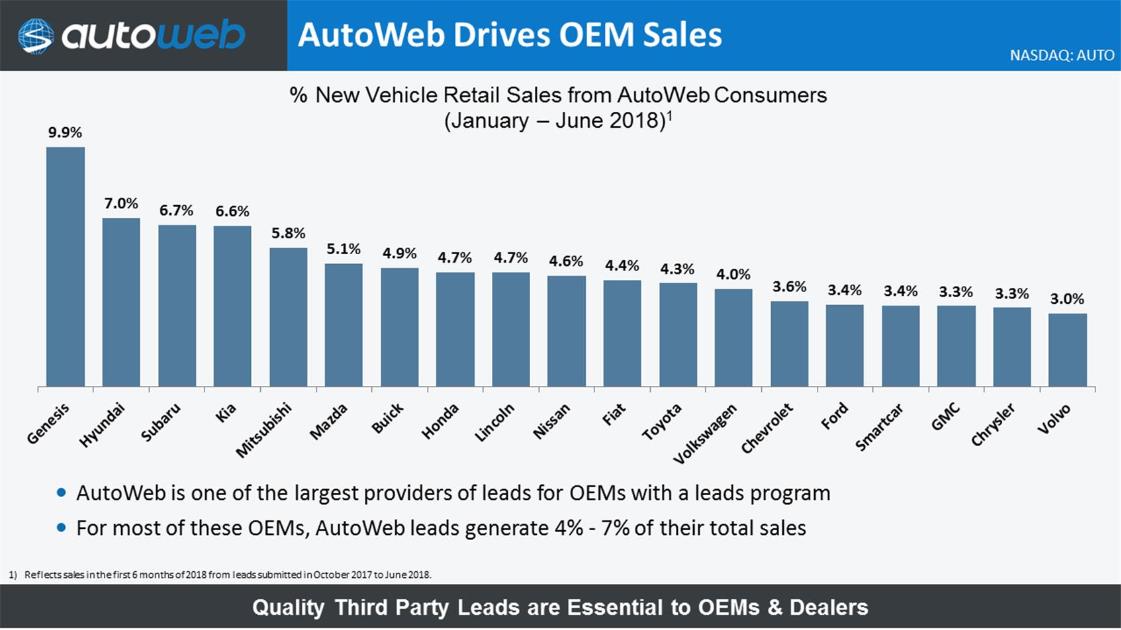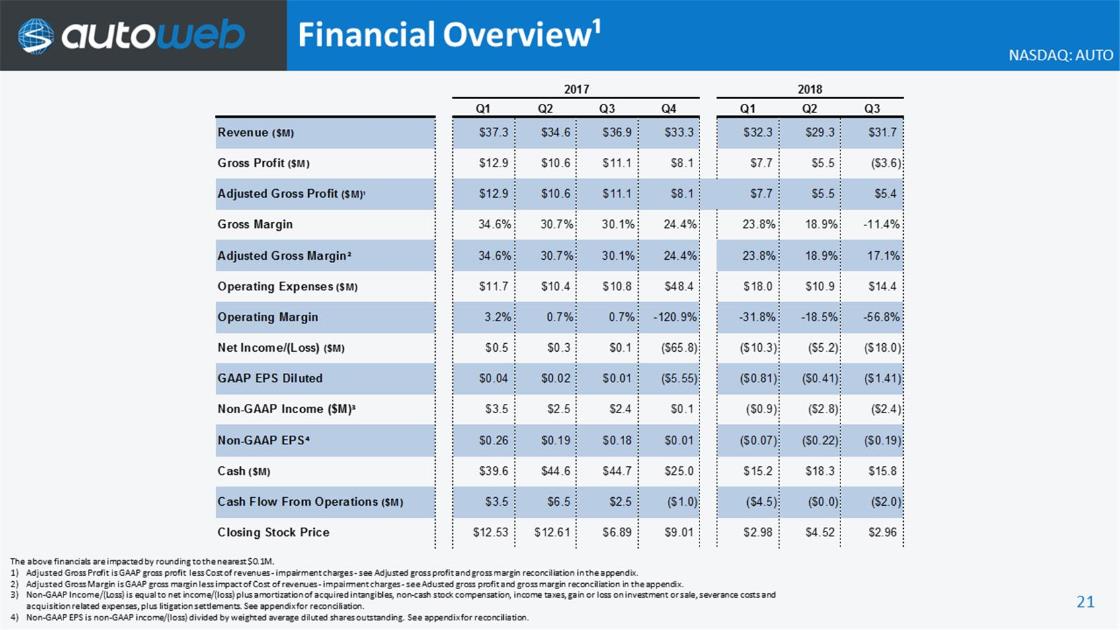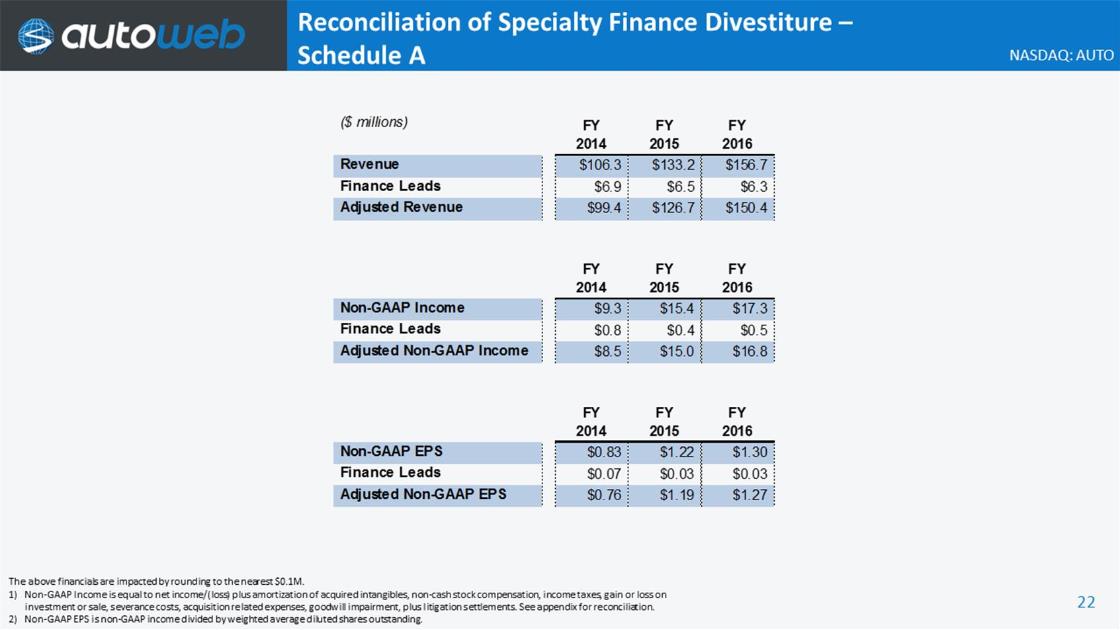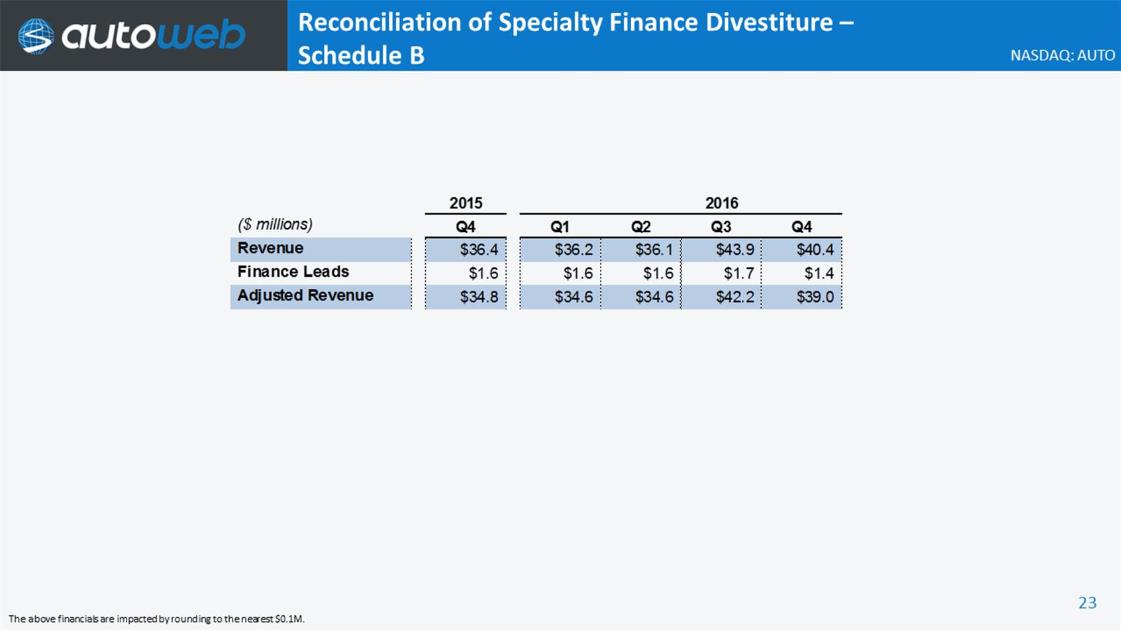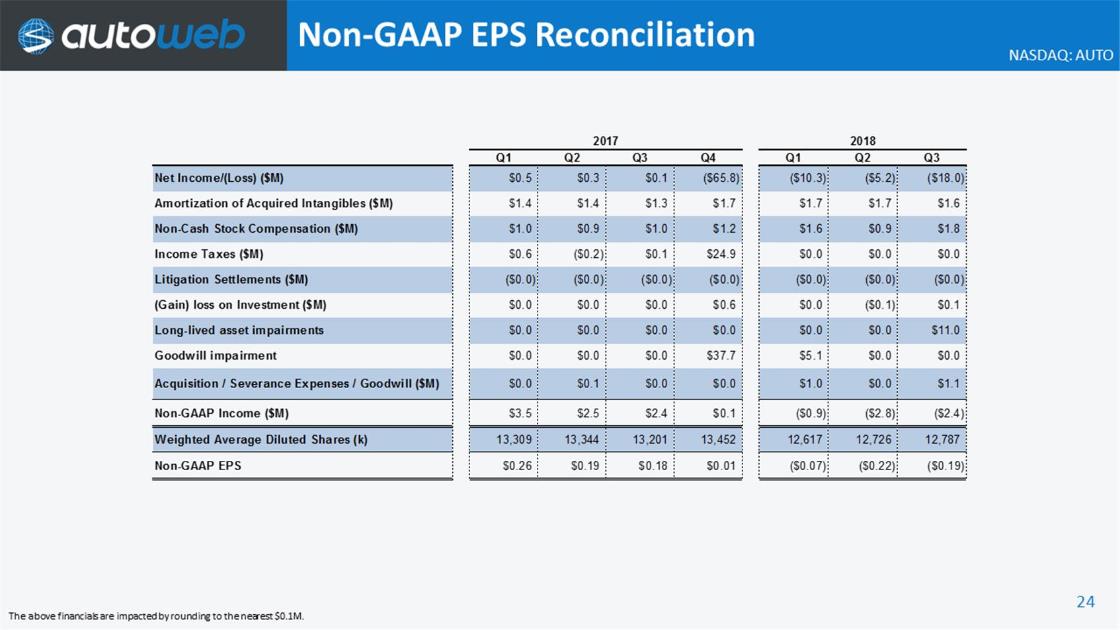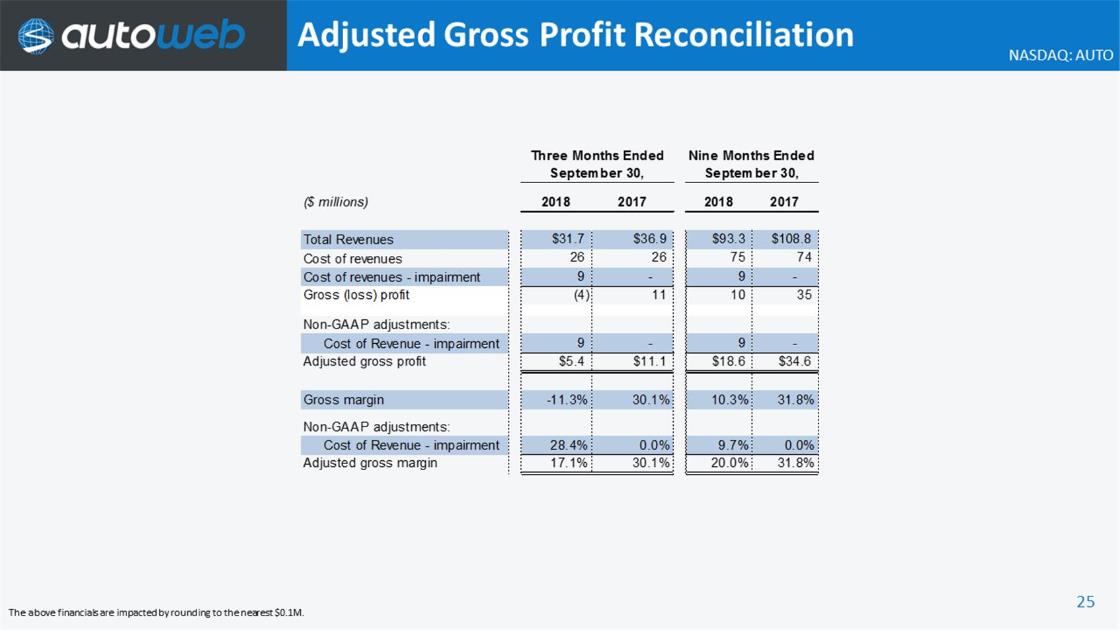Blueprint
Exhibit
99.2
AUTOWEB, INC.
Moderator: Sean Mansouri
November 8, 2018
5:00 p.m. ET
OPERATOR:
This is Conference # 9376169.
Operator:
Good
afternoon, everyone, and thank you for participating in
today’s conference call for us to discuss AutoWeb’s
financial results for the third quarter ended September 30,
2018.
Joining
us today are AutoWeb’s CEO, Jared Rowe; the company’s
interim CFO, Wes Ozima; and the company’s outside Investor
Relations advisor, Sean Mansouri with Liolios. Following their
remarks, we’ll open the call for your questions. As a
reminder, this conference call is being recorded.
I would
now like to turn the call over to Mr. Mansouri for some
introductory comments.
Sean
Mansouri:
Thank you, Noelle. Before I introduce Jared, I remind you that
during today’s call, including the question-and-answer
session, statements that are not historical facts, including many
projections, statements regarding future events or future financial
performance or statements of intent or belief are forward-looking
statements and are covered by the Safe Harbor disclaimers contained
in today’s press release, the slides accompany this
presentation and the company’s public filings with the SEC.
Actual outcomes and results may differ materially from what is
expressed in or implied by these forward-looking
statements.
Specifically,
please refer to the company’s Form 10-Q for the third quarter
ended September 30, 2018, which was filed prior to this call as
well as other filings made by AutoWeb with the SEC from time to
time. These filings identify factors that could cause results to
differ materially from those forward-looking
statements.
There
are slides included in today’s presentation to help
illustrate some of the points being made and discussed during the
call. The slides can be accessed by visiting AutoWeb’s
website at www.autoweb.com. When there, go to Investors and then
click on Events & Presentations.
Please
also note that during this call and/or in the accompanying slides,
management will be disclosing non-GAAP loss or income, non-GAAP
EPS, adjusted gross profit and gross margin. These are non-GAAP
financial measures as defined by SEC Regulation G. Reconciliations
of these non-GAAP financial measures to the most directly
comparable GAAP measures are included in today’s press
release and slides, which are posted on the company’s
website.
And
with that, I’ll turn the call over to Jared.
Jared
R.
Rowe:
Thanks, Sean, and good afternoon, everyone. Since I joined AutoWeb
earlier this year, our team has conducted a comprehensive review of
our operations and go-to-market approach to better align with our
mission of reestablishing AutoWeb as a premier matchmaker of
consumers and automotive providers.
Now
this review included an assessment of our products, traffic
acquisition, pricing policies, distribution channels, technology
infrastructure, strategic positioning and organizational structure
as well as our long-term prospects in the future of
mobility.
Now as
an outcome of this review and in an effort to improve transparency
with our shareholders, we have introduced several new operating
metrics that we plan to report on a quarterly basis including
measures to help assess audience size, traffic acquisition
efficiency and distribution channel effectiveness. Wes will expand
upon these new metrics but they can also be found in the
presentation posted in the investor section of our
website.
Now the
assessment of our go-to-market approach could not have come at a
more important time given recent industry dynamics in the
automotive environment at large. Interest rates have steadily been
on the rise, which is impacting the affordability of cars for
consumers.
When
the U.S. automotive industry hit record sales in 2016, the Federal
Reserve benchmark interest rate was between 0.5 percent and 0.75
percent. Now it’s between 2 percent and 2.5 percent.
According to industry reports, if the rate moves to a range of 2.75
percent to 3 percent, by next September, consumers will pay more
than $6,000 on average in interest alone to finance a
vehicle.
Now in
addition to the impact from rising interest rates, OEMs are
beginning to cut incentives considerably. In September alone, OEM
incentives declined nearly 3 percent compared to September of 2017.
Despite the slight increase in new car sales in October, we believe
that the auto environment has – we’ve experienced for
several years has been unsustainable and the reality is beginning
to settle in.
Now on
the digital media front, trends continue to shift towards mobile,
social media and voice search. While mobile and social media have
been front and center for several years now, the use of voice
assistance in the U.S. is expected to grow by 129 percent in 2018
compared to the prior year, totaling 35.6 million Americans using
the service at least once per month.
And
finally, today’s consumer. Today’s consumer is unique,
and consumers expect a unique experience for a unique vehicle. In
2018 models alone, there were more than 2,600 make, model and trim
combinations of vehicles. Couple that with the market dynamics of
search, digital media and affordability constraint and automotive
providers now find themselves in a highly complex environment to
attract, convert and retain customers.
So what
does all this mean for a digital marketing platform like AutoWeb?
It means that we’re going to have to provide our dealer and
OEM clients with a better and more integrated product suite, one
that is more data informed to ensure superior customer experience:
a product suite that connects the right consumer with the right
dealer to match the expectations of both parties. This data-driven
approach is imperative as we have been underutilizing the millions
of consumer data points that we collect each month.
Equally
important, these high-quality performance managed marketing
campaigns need to include detailed attribution to ensure the value
we’re providing to our clients is abundantly clear. And by
attribution, I don’t mean telling a dealer that a consumer we
gave them bought a car within 90 days. It means showing the dealer
that we helped them achieve their monthly sales goals.
From a
consumer perspective, our products and content will have to be
optimized to suit the requirements of mobile search as well as
social media and voice search down the road, given the rapidly
growing presence of these channels.
Ultimately, if we
can simplify the online car shopping experience with innovative
digital media solutions that market our client’s brand ahead
of our own and deliver a high-quality customer experience,
we’ll be best positioned to capitalize on the new environment
in which we find ourselves. All of this was heavily considered
during our strategic review.
During
the third quarter, we began to execute against our new plan,
beginning with the reset of our senior leadership team. This
resulted in a charge that impacted the bottom line in Q3 but serves
as a catalyst for rebuilding and strengthening our organization
with key personnel that align with our new strategic
imperatives.
Our
strategic review also included an assessment of the company’s
assets and licenses. As a result of our reevaluation of the DealerX
data and consumer targeting platform, we concluded that the
effectiveness of the solution was not in line with the enhanced
consumer-to-client matchmaking that we are seeking and have thus
taken a charge to write down the platform license.
In
addition, we have impaired 2 other assets related to GoMoto and
SaleMove, neither of which align with our new strategic
rationale.
As
discussed on previous calls, we have begun to modernize and
contemporize our approach to traffic acquisition. These changes
have delivered some early results as reflected by the 8 percent
sequential improvement in lead traffic.
Further, our
pricing rationalization and revised client engagement approach has
led to our first sequential increase in retail dealer count since
Q4 2015. By growing our audience and our retail dealer count, we
have shown that our revised operating approach is having a positive
impact on 2 critical drivers of our success.
While
we’re encouraged by the early signs of improvement in our
business, we still have plenty of work to return AutoWeb to growth
and profitability. We believe that revenue growth and margin
expansion will ultimately come from: one, audience growth; two,
improved audience acquisition efficiency; three, retail dealer
count and lead capacity growth; four, operational integration and
simplification; and five, enhanced consumer-to-client matchmaking.
I’ll expand on each of these later in the call but first,
I’d like to turn it over to Wes to walk through the details
of our Q3 results. Wes?
Wesley
Ozima:
Thank you, Jared, and good afternoon, everyone. Third quarter
revenue came in at $31.7 million, down from $36.9 million in the
year-ago quarter.
Advertising
revenues were $6.6 million compared to $8.9 million in the year-ago
quarter with click revenues of $5.6 million compared to $7.4
million. These declines were primarily due to lower retail dealer
count and lower lead and click volumes.
Gross
profit during the third quarter was negative $3.6 million compared
to $11.1 million in the year-ago quarter with gross margin coming
in at negative 11.4 percent compared to 30.1 percent. The decline
was primarily driven by a onetime impairment charge to cost of
revenues of $9 million associated with the dealer platform –
DealerX platform license.
Adjusted gross
profit, which excludes the onetime DealerX impairment charge of $9
million, was $5.4 million compared to gross profit of $11.1 million
in the year-ago quarter, with the decrease driven by continued
investments in traffic acquisition strategies and testing of new
traffic sources as well as in a favorable mix of retail and OEM
lead revenue, which Jared will expand upon later in the call. As a
percentage of revenue, adjusted gross profit was 17.1
percent.
Total
operating expenses in the third quarter were $14.4 million compared
to $10.8 million last year. The increase was primarily driven by
onetime severance costs related to a management reorganization as
well as onetime long-lived asset impairment charges associated with
acquired customer relationships and SaleMove.
On a
GAAP basis, net loss in the third quarter was $18 million or a
negative $1.41 per share on 12.8 million shares compared to net
income of $0.1 million or $0.01 per share on 13.2 million shares in
the year-ago quarter.
For the
third quarter, non-GAAP loss, which adds back amortization of
acquired intangibles, noncash stock-based compensation, severance
costs, gain or loss on investment or sale, litigation settlements,
goodwill impairment, long-lived asset impairments and income taxes,
was $2.4 million or negative $0.19 per share compared to non-GAAP
income of $2.4 million or $0.18 per share in the third quarter of
2017. The decline was primarily driven by the aforementioned lower
revenues and adjusted gross profit.
Cash
used by operations in the third quarter were $2 million compared to
cash provided by operations of $2.9 million in the second quarter
and $2.5 million in the prior year quarter, with the decrease
primarily driven by severance-related cost as well as professional
service fees and timing of receivables.
Note
that we currently expect incremental cash burn to continue into
next year as we invest in our people, products and technology to
enable our return to growth and margin expansion in
2019.
At
September 30, 2018, cash and cash equivalents stood at $15.8
million compared to $18.3 million at June 30, and $25 million at
December 31, 2017. The decrease from 2017 year-end was primarily
driven by a repayment of an $8 million revolving line of credit as
well as severance-related costs.
Total
debt at September 30, 2018 was $1 million compared to $9 million at
the end of 2017.
As
Jared mentioned, going forward we will be providing several key
operating metrics that we believe are instrumental to understanding
the new direction of our business, including lead volume at source,
lead traffic, retail dealer count and retail lead capacity as well
as click volume and revenue per click.
Note
that we also intend to provide click traffic going forward,
however, we’re still working to accumulate the historical
data. We’ll expect to have it prepared by our next quarterly
earnings report.
With
that, during the third quarter, we delivered approximately 1.9
million automotive leads compared to 1.7 million in the second
quarter and 2.1 million in the year-ago period. Note that this
figure includes total new and used vehicle leads invoiced at both
at our OEM and retail clients.
The
sequential improvement was largely driven by higher traffic
partially offset by conversion rate inefficiencies resulting from
historical underinvestment in our mobile environments.
Total
lead volume was also offset by our revised lead distribution
policies as we look to sell a greater mix of leads to our
higher-price retail channel.
Lead
traffic was 27.6 million visits during third quarter compared to
25.5 million in the second quarter and 28.5 million in Q3 2017. The
sequential improvement is reflective of the early benefits from
modernizing and contemporizing our approach to traffic acquisition.
Note that these visits reflect a number of consumers who visit our
entire portfolio of websites during the quarter – lead
websites during the quarter.
Retail
dealer count was 2,577 compared to 2,550 in the second quarter and
3,242 in Q3 2017. As Jared mentioned earlier, this marks our first
sequential increase since Q4 2015 evidencing that our new operating
approach is beginning to take root.
Note
that this dealer count figure includes a number of franchise
dealers contracted for delivery of retail new vehicle leads plus
the number of franchised or independent dealers contracted for
delivery of retail used vehicle leads.
Retail
lead capacity was 441,000 lead targets compared to 449,000 in the
second quarter and 578,000 in Q3 2017. The decrease in retail lead
capacity was primarily driven by lower budgets set by our retail
dealer clients, which is reflective of the lower product quality
that we are aggressively working to improve. Note that retail lead
capacity is the sum of the number of new and used vehicle leads
that a retail dealer’s clients wish to receive each month
during the quarter.
Estimated buy rates
released generated from our entire portfolio of websites for the
quarter was 17 percent. Note that this buy rate reflects the
percentage of consumers submitting leads through one of our media
properties that purchase a vehicle within 90 days of lead
submission.
Our
lead sourcing mix for the quarter also remained steady with 78
percent of leads being internally generated from our media
properties and the other 22 percent of leads coming from
third-party lead providers. We continue to believe our roughly
80-20 mix is an appropriate target to balance quality and quantity
of our core lead product.
Moving
on to our click product. Click volume in the third quarter was 6.6
million clicks compared to 6.3 million in the second quarter and
7.3 million in Q3 2017. Revenue per click was $0.84 compared to
$0.92 Q2 2018 and $1.02 in Q3 2017.
With
that, I’ll now turn the call back over to Jared.
Jared
R.
Rowe:
Thanks, Wes. As I mentioned earlier, our core mission and goal as a
company is to once again become a premier matchmaker of consumers
and automotive providers through leads, click and e-mail
campaigns.
This
goal will ultimately be achieved by the execution of 5 critical
initiatives: first, we need to grow our audience; second, we need
improved audience acquisition efficiency; third, retail dealer
count and lead capacity growth; fourth, operational integration and
simplification; and fifth, enhanced consumer-to-client matchmaking.
We believe that the execution of these initiatives will return
AutoWeb to growth and margin expansion.
To grow
our audience and improve acquisition efficiency, we have begun to
deploy a series of new traffic acquisition methodologies. As I
mentioned earlier, I believe some of the company’s previous
strategies were not contemporary or optimized to consumer buying
signals and our goal is to move away from commodity matching of
buyers and sellers.
We are
now looking at more data-driven approaches to connect a specific
target buyer with a specific targeted seller. We believe this can
help us differentiate ourselves in the market as well as improve
both the margin and volume characteristic of our
business.
Further, we intend
to take advantage of modern approach just to content optimization,
of which we have not availed ourselves historically. We expect
these investments to continue over the near term as we work to
optimize our traffic acquisition methods, improve lead and click
conversion and return to growth.
For
retail dealer count and capacity, there are several elements
we’ve considered to drive growth, with the first being a
pricing rationalization of our products. For context, the company
has not the volume and pricing trade-offs between our distribution
channels. This lack of optimization has unnecessarily distressed
our retail dealer participation rates and blended
margin.
Rationalizing our
price per lead by even just a few cents will be a net positive to
both our top and bottom line. And the same distribution channel
dynamic goes for our click product.
Note
that clicks are largely driven by abandonment traffic and on our
lead forms, so a concession on click pricing in exchange for more
volume still leads to very high contribution margin. We’ve
already begun to see a modest benefit of this pricing
rationalization with an increase in retail dealer count, which is
an important metric for our business.
We also
plan to grow our retail dealer count capacity through better market
segmentation. Today, the top 150 dealer groups in the U.S. have a
combined 3,660 dealers. Of those 3,660 dealers, we currently sell
leads to less than 10 percent.
This
alone presents a unique opportunity with a highly under-penetrated
segment of the marketplace that spends considerable amounts on
media. We believe that we have a very compelling and cost-effective
solution for this client segment.
Our
initiative to simplify and better integrate our operations is
really geared towards corporate level efficiency. Previously,
AutoWeb was largely run like a group of loosely affiliated
companies, given the acquisitions made over the last 4
years.
We’ve also
found that the company lacked a modern IT infrastructure, which
inhibits automation and limits our ability to drive appropriate
levels of operational efficiency. We intend to invest in our IT
infrastructure and better integrate our operations so that we can
minimize redundancies, improve the velocity of change and gain
better control over internal investments and outcomes.
To
enhance consumer to client matchmaking, we are reinvesting in and
further integrating our 3 core products. At a high level,
we’re currently investing in data-driven product research to
better understand the needs of buyers and sellers. We understand
that we need to deliver value to both consumers and clients
alike.
Our
goal is to be the best matchmaker in an industry that’s
rapidly changing, and we have to invest and conduct research at a
very detailed level, so that we can better tailor our products to
best take advantage of the evolving market dynamics detailed
earlier.
For
leads, this includes better understanding of the needs and wants of
consumers, so they can be matched with a dealer that is well
positioned to meet those needs. In today’s environment,
consumers make automotive buying decisions based on dimensions
beyond just product, price and brand loyalty.
In
fact, McKinsey research shows that 90 percent of consumers make
purchasing decisions based on their shopping experience, not on any
form of loyalty. That is telling in that it highlights the
importance of buyers and sellers sharing expectations around how
the transactions should be managed.
For
clicks, on our last call, we stated that we would deploy a revised
click algorithm by the end of the year. I’m happy to report
that as of October 24, 10 percent of our click traffic was exposed
to this new algorithm that is using more than 31 data points to
match consumers and clients as opposed to the historical approach
of 3 data points. Also, this approach includes a machine learning
component that will help us stay current with the changing needs of
consumers and clients.
Up to
this point, the new click algorithm has already begun to show early
signs of improving the consumer-to-client match, which is enhancing
monetization. In fact, beginning on November 6, we began to expose
25 percent of our click traffic to the new algorithm, giving these
– given these early strong results.
And for
e-mails, this medium provides us with sequential messaging
opportunities for clients. Also, these messages can be optimized
based on the wealth of first-party data that we generate. A more
database marketing approach to managing this unleveraged asset
should help enhance our monetization efforts and the value of our
other 2 core lead and click products over time.
Equally
important to each of these individual product investments,
we’re keenly focused on the integration of our products into
a more unified solution. We want our lead data to speak to our
clicks and both sets of data to speak to our e-mail marketing
campaigns. These 3 product - key products will be working together
with the ultimate goals monetizing every add and pricing we
generate across these products.
As I
mentioned earlier, historically, we have under-invested in our
mobile experience. There is opportunity for business improvement
through mobile enablement, and ultimately, mobile optimization.
This lack of investment has led to sell-off more customer
experience, lower lead and click traffic and conversion
rates.
In
closing, I’d like to reiterate a few key points. I’m
very pleased with the progress that we’ve made and the steps
we’ve taken to address our challenges over the last 7 months.
The execution of our turnaround is proceeding according to
plan.
There
are opportunities to be more efficient with the existing resources
we have today, and to compete more effectively with – for our
clients’ marketing spend. Marketing efficiency is critical in
the automotive industry, and we aim to continue to be at the
forefront of helping our clients achieve their goals and market
their brands ahead of our own.
As we
look ahead to 2019, we have every expectation of returning to
growth and margin expansion. However, it will take some time as we
continue to integrate and invest in our products, improve our
operational execution, simplify our organization and invest in our
people.
I thank
all of our shareholders for their patience and look forward to the
journey ahead. With that, we’ll now open up the call for
questions.
Operator:
Thank you sir. Ladies and gentlemen, if you have a question at this
time please press the star then the number one key on your
touchtone telephone. If your question has been answered or you wish
to remove yourself from the queue, please press the pound key.
Again, that’s star then one to ask a question.
To
prevent any background noise, we ask that you please place your
line on mute once your question has been stated.
And our
first question will come from Sameet Sinha from B. Riley
FBR.
Lee T.
Krowl:
This is actually Lee Krowl filling in for Sameet. A lot to digest
here, especially with the new metrics, but definitely a great
overview. Just wanted to start out on the traffic acquisition
strategies.
I know
you kind of discussed them briefly but can you just maybe dive in a
little bit deeper on the specific changes you’ve made? And
just kind of surprised how quickly they’re starting to
materialize into tangible results. So may be a little more detail
would be helpful to start out.
Jared
R.
Rowe:
Wonderful. Good to chat with you, Lee. Thanks for the question. As
we think about traffic acquisition, there’s a couple of key
investments that we started to make.
One is
we’ve really started to shift our acquisition strategy away
from keyword buying and more focused on audience segmentation and
audience segmentation – or segment targeting. That’s a
fairly standard kind of macro trend that you’re seeing in
search overall and we really haven’t taken advantage of it.
So we’ve made significant investments in that
area.
The
second thing we’ve started to do is we have started to attack
not just the acquisition side but also the engagement and the
conversion side. I mentioned earlier in my prepared remarks about
some of the investments we’re making on the mobile enablement
side. We think that that’s going to bear some fruit for us as
well. And we do think that that’s some low-hanging
opportunity for us.
So a
lot of our focus has really been around rebuilding our campaigns,
focusing on revised segments of consumers and then making certain
that we’re providing them with experiences that are optimized
to click-through rate and conversion. Because like I’ve said
on previous calls, it’s not just about buying the
impressions, it’s about what you do with them once you get
them and we have to be far more efficient and effective than we
have in the past.
Lee T.
Krowl:
Got it. And then switching over to clicks. It looks like the volume
improved sequentially and it appears like that’s a function
of pricing. Just kind of your thoughts, especially because it seems
like it’s more of a priority now, your willingness to lower
price to drive volumes. Should we expect that the revenue per click
continues to trend lower as you try to attract more
volumes?
Jared
R.
Rowe:
As we think about this, there’s a couple of components to
this. One is the pricing rationalization. The second is making
certain that the clicks get into the distribution channel that we
want them to from a margin perspective.
So
we’ve talked a lot about the lead side of the business and
how there’s a margin differential between the retail side and
the OEM side. And so getting that mix right will be an important
part of how we expand margin in 2019.
The
same dynamic’s actually true inside of the clicks business as
well. We’ve got endemic buyers and we’ve got nonendemic
bars of the clicks product. As you can imagine, the endemic buyers,
the pricing is better, the margin is better as opposed to the
nonendemic buyers. And the reason is because an endemic buyer
values low funnel, high-quality automotive traffic more than an
nonendemic buyer does.
So as
we think about things, it’s about driving the volume but
it’s also about making certain that the mix is optimized as
well because we think, over time, that’ll have a positive
impact on margin. So yes, you could see the revenue per click going
down.
However, as long as
we’re managing that appropriately and it’s going into
the right channel, it could be and should be margin accretive over
time. So again, the dynamic that we’re managing on the lead
side is the same dynamic that we’re managing on the click
side.
Lee T.
Krowl:
Got it. And then just you kind of alluded to the fact that the
infrastructure is quite dated. Is there a way to quantify maybe the
quarterly CapEx required or investment that’s going to come
on in order to modernize the platform?
Jared
R.
Rowe:
We’re still working through the final 2019 investment plan.
We’ve got the forecast and we know we’re going to be
able to – or we believe we’re going to be able to get
back to growth and margin expansion and that includes the
investment associated with the technology
infrastructure.
Here’s, I
guess, the way that I would frame the technology infrastructure
investment requirements. And Lee, I’m going to try and answer
your question, but I may not answer it quite as completely as
you’d like. We believe that the infrastructure, as is sits
today, will not necessarily impair our ability to drive the early
stages of the turnaround.
We
think we can improve the financial performance of this business
with the very infrastructure we have. However, the later stages of
the turnaround, we think are going to require a more up-to-date
technology infrastructure.
So as
we think about things, we think about how we feather this
investment in over time and how do we calendarize it appropriately,
so that we can continue to turn and drive what we have said we were
going to do here today, which is we believe we’re going to be
able to grow top line growth year-over-year and margin expansion
next year. And that does include the investments that we’re
going to need to turn the technology infrastructure over, over
time.
To be
quite candid with you, Lee, the kind of work that we’re going
to have to do on our technology infrastructure is going to be a
multiyear exercise. And again, we believe that we can actually
feather the investments in as we improve the financial performance
of the business.
Operator:
Our next question comes from Eric Martinuzzi with Lake
Street.
Eric
Martinuzzi:
I wanted to take a look at the strategic review that you conducted.
I’ve got you – I understand from the press release and
your prepared remarks you’ve got new management and new
metrics, but I didn’t see anything really a fundamental pivot
or shift of divestments and acquisition, of getting out of one
business, doubling down on something else.
It all
seems kind of tactical to me as opposed to strategic. Was there a
discussion at the board, at the management level as far as things
like maybe getting out of used and doubling down on new; or getting
out of clicks and doubling down on leads; Retail versus OEM;
M&A; those kinds of things?
Jared
R.
Rowe:
Eric, yes, appreciate the question. Yes, we did. We did. And so
when you actually look at the – what we’re putting
forward here today, it actually does address some of the things you
do and maybe just not as – that you mentioned there, just
maybe not as directly as maybe we could have been,
clearly.
We are
going to continue to focus on new car. That is our dominant area of
expertise and it’s where we think we can really add some
value to the marketplace. That doesn’t mean that we
won’t have a new car – or a used car component to our
business, I’m sorry. It just means that it’ll be a much
smaller component of our business than a new car side is. So we
intend to stay focused on the new car side.
There
are fewer competitors in that space, and again, we think
we’re uniquely positioned to deliver value there. We also
intend to really integrate our products into a solution. While that
may not sound very strategic, it actually provides us with the
ability to deliver far more value to our clients than we can when
we think about our products as individual product
SKUs.
So the
clicks and the leads product working together much more closely
with a much more data-informed approach, we think will actually be
a strategic advantage for us over time, in particular, when you
layer in the e-mail component, will allow us to do sequential
messaging, multi-tier sequential messaging to the benefit of our
consumers and our clients.
Also,
we did reference early and it was a very small reference, about
mobility. We believe that mobility services and figuring out how to
connect buyers and sellers in ways other than just buying and
selling cars is going to be an important part of our future. But
that is about being a matchmaker. We also had a long conversation
about some of the emerging trends from a search
perspective.
So
while today, just about everything we do is desktop or mobile, when
you look at the search trends overall, voice search is coming
online in a big way, image search is behind it. We intend to
actually build our platform in such a way that we’re going to
be able to position ourselves to take advantage of some of those
trends over time as well.
Now,
you asked the question about divestitures. Really, the divestitures
came in the form of focus, and we mentioned a couple of those.
We’re going to stop focusing on some things that we believe
to be noncore, and we’re going to focus on really rebuilding
our foundation here. So that’s where the divestitures really
came in.
It’s not a
true divestiture in terms of we sold something, but it’s a
divestiture in the form of we’re not going to work on some
things any more. We’re going to get focused on what drives
real value. Also, in terms of acquisitions, I’m just a big
believer that if you’re going to acquire something, you
better have an operating model and a solid foundation as a business
because, as you well know, it’s easy to buy stuff, it’s
hard to actually integrate stuff.
We
bought a bunch of companies over the last 4 years. We’re
going to integrate them. We’re going to simplify this
business. And we’re going to harden our infrastructure and
our foundation in such a way so that when we want to be
opportunistic, as it relates to acquiring capabilities, we’re
better prepared to do it so that we can make the most out of those
investments.
So we
did talk about all that. This plan does encompass that thinking. A
lot of it is tactical right now to be quite candid with you. Just
understand we’re thinking strategically. We just know that
we’ve got to do a bunch of tactical work to really harden our
infrastructure and improve our financial performance, so that we
can then successfully do some of the things that you
mentioned.
Does
that answer your question?
Eric
Martinuzzi:
Yes. I have a follow-up question regarding the divestiture or the
refocusing or more intense focusing. DealerX, in October 2017,
Autobytel at the time spent $8 million for a license to
DealerX.
Did
that just go up in smoke? Or is there a potential to sell that
license and somehow monetize that $8 million investment? I know it
wasn’t on your watch, but is that over?
Jared
R.
Rowe:
Yes, I hear. That’s a good question, Eric. We don’t see
any value – any way to harvest any value out of it going
forward. We took a look at it and, quite frankly, we think
we’re better off taking our finite resources and getting the
focus back on some of the surer ways that we’ve got in front
of us to enhance our consumer acquisition and conversion
approaches.
So that
is how we think about that. You never make a business decision
based on a sunk cost and this is about how we really optimize our
approach going forward, and we’re trying to spend a little
less time, at least I am as a leader here, looking backwards. So
that would be my answer to that, Eric.
Eric
Martinuzzi:
OK. One of the other things that sometimes takes sometimes place
after a strategic review is a restructuring that impacts headcount.
I didn’t see it specifically highlighted here. I know
you’ve been tuning your work force, certainly at the senior
leadership level.
Have we
– has there been a – some summation of the cost savings
since you started implementing some of your changes? We pulled $2
million out of the cost structure on an annualized basis or we
pulled $4 million – something to that extent in this
refocusing of the effort there’s also a fine tuning of the
headcount. Has anything like that taken place or is that in the
works?
Jared
R.
Rowe:
Yes. No, it has. As we think about things, one of the reasons
– I’m a big believer that restructuring should start at
the top of an organization not the bottom. And so really what you
saw with the change, I guess, it was a couple of months ago now is
us creating capacity to reinvest back in the business and build
some capabilities that we need to build.
So as
we think about headcount, we think about it that way more than
anything, which is as we manage this business and as we need
capacity or investment dollars, we intend to find the capacity
within the organization so that we can drive the changes we need to
drive.
So it
wasn’t that the restructuring was really focused on how we
drop the money to the bottom line; it was more about how do we open
up capacity to make the investments from a headcount perspective
that we need to make, to add some capabilities to this business to
actually really drive the turn that we’re working
on.
Eric
Martinuzzi:
OK. I know you’re not in a situation where you’re
comfortable giving guidance, but you at least are talking to what I
think is a primary concern for most people. We’ve got a
contracting top line here. We actually had a decent Q3 versus
consensus estimates, but Q3 is historically a seasonally strong one
for AutoWeb.
A
return to growth in 2019. Would you care to more clearly delineate
the time line for that? Is this a first half phenomenon? Is this a
second half 2019? What’s the board and the management’s
thinking on the growth opportunity?
Jared
R.
Rowe:
I guess here is the way I would frame it, Eric, as Wes talked about
the fact that we are going to need to continue to make investments
into 2019. When you couple that with what I stated in our –
in my prepared remarks about how we’re going to get to the
annualized growth with margin expansion, I think, hopefully,
that’ll help you kind of understand how we’re thinking
about it.
We do
have some investments to make yet and we’re going to continue
to drive those investments into the business, but we don’t
believe that those investments are going to inhibit our ability to
actually get back to year-over-year growth and margin expansion in
‘19.
Eric
Martinuzzi:
OK. All right. And then the dealer count, the sequential
improvement that, obviously, you pointed that out and highlighted
that as an example of some progress here. I go back to the
seasonality question. Is partly the dealer count being up Q3 versus
Q2 a symptom of seasonality? Or another way to ask that is, in Q4,
could that dealer count decline versus Q3?
Jared
R.
Rowe:
We had 10 straight quarters of decline, and we were able to turn
that last quarter. So I don’t think that was seasonality. In
particular, since we actually made some very specific changes to
our go-to-market approach, and we saw the impact of that. So I
don’t believe it was seasonality last month. And we feel good
about the momentum we have in Q4. So we’re starting off on
the right foot here in Q4.
Operator:
Thank you. As a reminder, ladies and gentlemen, that’s star
then one to ask a question.
Our
next question comes from Ed Woo with Ascendiant
Capital.
Ed
Woo:
In terms of the restructuring or, I guess, strategic review, do you
feel that most of the major review is done and any changes would be
pretty minor, at least with the near term?
Jared
R.
Rowe:
Ed, thanks for the question. Yes, yes. We feel really good.
We’re – the way I talk about it internally is
we’re at the end of the beginning and the beginning of the
next phase here. And that’s really how we’re viewing
this.
Last
quarter, we really started to implement some of the new thinking
and is why you’re seeing some of the results you’re
seeing here in the audience and in the dealer side. We’re
really now kind of focused on the execution phase, really building
momentum towards 2019, so that we can have a much stronger 2019
than we did 2018. So yes, absolutely, I think the strategic work is
done. We’re now in the execution phase here.
Ed
Woo:
Great. And as part of your strategic view, how has the landscape,
competitive landscape impacted your outlook? And what does it mean
– does it make your job a lot tougher?
Jared
R.
Rowe:
No, we like the competitive landscape, believe it or not. And the
reason we like it is because there aren’t many folks focused
on new car, right? Most of the big players in the space are really
focused on used car. We also like the fact that we have unique
capabilities as it relates to search arbitrage and lead gen,
right?
We’re the
leader as it relates to lead gen in the new car industry. So we
like the positioning of the business. To be quite candid with you,
we also like the challenger brand aspect of this.
We
think it gives us an opportunity to really focus on delivering
value to the – to our – to the end clients and do it in
a very cost-effective way for them. So there’s a lot of big
players and there’s a lot folks who are very, very good at
what they do. We just like the way the market is laid out as we sit
today, and we like our chances to get this business back to where
it should be.
Ed
Woo: Great.
And my last question is just on your outlook for the car sales for
the – in industry car sales. It looks like the Fed is going
to keep raising rates and obviously, that’s going to be
weighing out on the outlook of the industry car sales. Do you see
that there’s going to be big changes near term or you think
it’s something likely to happen in mid-2019 before the car
sales really change from where it’s at
currently?
Jared
R.
Rowe:
I think what we’ve hit is we’ve hit the peak and I
think we’re going to start a slow decline here. When you take
that all the way back, Ed, to the question you asked previously
about the competitive landscape, that’s one of the reasons
why I like our challenger brand positioning as we sit right now is
because with demand pulling back a little bit, likely over the next
several quarters, supply it still hasn’t been trimmed down
the way you’d expect it to be.
So we
know that there’s going to be a lot of vehicles that are
going to need to be sold. And in an environment where OEMs and
dealers are competing more heavily for the consumers, that’s
actually good for us, not bad for us, because they’ll churn
the market, which actually helps drive us forward as well as it
positions us to, again, be a low-cost provider and support these
folks in their needs of selling these vehicles.
So I do
expect to see a more gradual decline over the next several
quarters, which, again, I actually think will help us a little bit
as we regain our footing.
Operator:
Our next question comes from JP Geygan with Global Value Investment
Corp.
James
Philip Geygan: I have 3 brief questions. You’ve talked
a lot about your strategic plan, but I was hoping you might
elaborate on how you arrived at this or the specific pain points it
may have addressed? And then recognizing that it seems like
you’re narrowing your focus or focusing your efforts,
won’t your strategic plan or what you’re building
internally help you to address any other markets in the
future?
Jared
R.
Rowe:
All right. Excellent. And I’m – I’m sorry, JP. I
got the first one, so it’s pain points addressed. Other
verticals was another question. I – you said you had 3 and I
think I might have missed one. My apologies.
James
Philip Geygan: Sure. Those were both parts of my first
question. My second would be if you can talk a little bit about
developing technology internally, whereas historically, the company
seems to have purchased technology. And then 3 would be fairly
straightforward. You seem to see some fairly optimistic signs. At
what point do you anticipate being able to scale this platform in a
meaningful way?
Jared
R.
Rowe:
Got it. OK. Thanks, JP. I apologize. OK. So the pain points that we
think this approach addresses. A couple. I’ll talk about
internal pain points and external pain points. From an internal
perspective, there are multiple pain points inside this business
because we really are kind of a loosely managed group of companies.
So I’m going to talk about strategically internal and
external.
Simplifying this
business, getting refocused and building a more unified operating
model, I think is going to reduce some of the complexity that
we’ve had internally and allow us to execute much more
completely.
On the
external side, when you look at what’s going on inside of the
car business, right, pricing bands have narrowed to the point where
there aren’t a lot of bad deals in the industry anymore.
Quality bands have narrowed to the point where there aren’t
bad cars anymore. We also know that loyalty is not something that
drives consumers’ purchase decisions.
Further, we see
consumers making decisions around what vehicle to buy based on
shopping experience more than other attributes. So we believe that
this business is shifting from a commodity matcher to a matchmaker
marketplace and we think we can lead that. You see a lot of folks
in the industry trying to change the way dealers do
business.
We
don’t want to do that. We don’t think that’s our
place. What we want to do is we want to help understand – or
we want to understand, I’m sorry, what makes dealers special
and unique. We want to understand what consumers value and we want
to connect those 2.
We
think that that is a real pain point in the industry, and we think
we’re uniquely positioned to actually help both buyer and
seller share expectations, so that when they actually interact to
start the transaction, they’re starting off in a much better
place than they do an awful lot these days when they don’t
share expectations or they have misalignment around how the
transaction should proceed.
So when
we talk about the kind of one of the core underpinnings of our
strategy, it really is that. This isn’t about a consumer who
wants to buy a Ford in a ZIP Code, it’s more about a consumer
who wants to buy a specific kind of vehicle in a market in a
specific way. We think we’re well-positioned to evolve our
business to be much more focused on the quality of the match as
opposed to just the volume and the geography within which a dealer
and a consumer reside.
Now,
once you’ve got that, to your point, is that extensible to
other verticals? Possibly. Absolutely possibly. We want to stay
focused on automotive as we sit here though today. We think
there’s a lot of good opportunity for us to drive growth. In
the future, if – once we have this built and we feel good
enough about it and we see other opportunities, we could absolutely
be opportunistic.
But I
can tell you as we sit right now, that’s not our focus. Our
focus is how do we be the best automotive matchmaker that we can be
because we see an awful lot of opportunity in this space if we can
just accomplish that.
The
second question you had was developing technology internally versus
externally. I tend to agree with you. I think we’ve gone
outside a bit more than we should as it relates to innovation and
there’s 2 components here.
One is
technology development and the other one, I would say, would be
just innovation in general. I think you need a balanced approach. I
think you need a mix. I think we’ve got good capabilities
internally as it relates to technology. I just don’t think
we’ve always maybe executed as effectively as we could.
That’s more of a planning and execution issue than it is a
core capabilities issue.
So I
think we can get better at just delivering technology in a more
efficient and effective way than we have historically. Because
again, I like the assets and capabilities that we have in that
regard.
Now,
external technology development, that is something that we’re
going to continue to look at as well. You need to have a blended
approach, but I think you need to be smart about build versus buy
versus rent. When we think about building technology, we’re
going to be much more focused on what gives us a unique competitive
advantage in the marketplace. That’s where we really need to
spend our energy and our effort.
If it
is more of a commodity function, I think you’ll see us focus
a little bit more on either external sourcing or having people
support us, because again, ultimately, we want to spend our energy
and focus on the things that we do best and really differentiates
us in the market.
Again,
for what it’s worth, I will tell you, I think that from a
technology development perspective, I think we’ve got some
untapped ability here that’s mainly been driven by our
execution model, and we are well down the road of assessing the
opportunities for us to improve in that regard.
And
then the last one you said is when do we get to start to scale the
platform again. I will tell you again, and I don’t mean to be
a broken record, I apologize, we expect to get to growth next year,
we expect to get to margin expansion next year. So we expect to get
to a point where we can start to rescale this platform next year,
because if we didn’t rescale it, we wouldn’t be able to
achieve those 2 objectives that we have.
James
Philip Geygan: Very good. Thank you for your time and we look
forward to watching the business continue to develop.
Jared
R.
Rowe:
Thanks, JP. Hopefully, that was helpful.
Operator:
At this time, this concludes our question-and-answer session. I
would now like to turn the call back over to Mr. Rowe for closing
remarks.
Jared
R.
Rowe:
Well, anyway – I apologize folks, (I’ve set aside my
script). Anyway, I just want to say thank you. Thanks everybody. We
very much appreciate your time. We appreciate your interest. We
very much appreciate your patience with this business. We do expect
to get this business back to growth and profitability next
year.
We know
that 2018 has not been the best year for anyone involved, but we
really like the assets and capabilities of this business, and
we’re excited about where we’re heading in 2019. So we
appreciate all the help. We appreciate the questions, and we look
forward to the journey ahead. Thank you.
Operator:
Ladies and gentlemen, this does conclude today’s
teleconference. You may disconnect your lines at this time. Thank
you for your participation.
END


